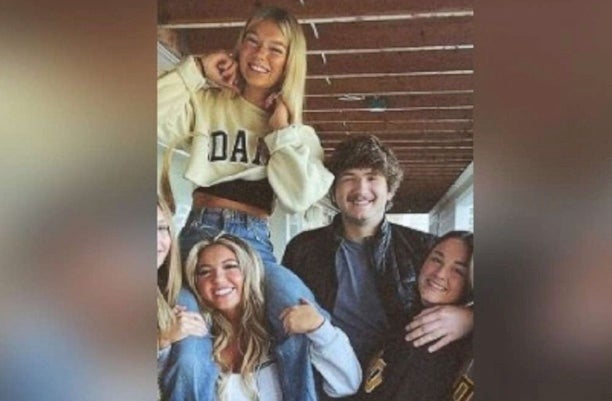Surgical gloves, trash disposal and car cleaning: Bryan Kohberger’s odd behaviour after Idaho murders revealed
During a period of surveillance, investigators observed the criminology student behaving suspiciously, including wearing surgical gloves, secretly dumping trash and rigorously cleaning his car
Suspected killer Bryan Kohberger was caught dumping trash in his neighbours’ bins in the dead of the night in the weeks after four University of Idaho students were brutally murdered, it has been revealed.
The 28-year-old criminal justice PhD student has been charged with the 13 November murders of Kaylee Goncalves, Madison Mogen, Xana Kernodle and Ethan Chapin that rocked the small, college town of Moscow, Idaho.
The net had been closing in on Mr Kohberger for several weeks and he was placed under surveillance by law enforcement for four days leading up to his arrest at his family home in Pennsylvania on 30 December.
The surveillance team was tasked with both keeping eyes on the suspect so that authorities could arrest him as soon as a warrant was obtained and obtaining a DNA sample that investigators could use to try to match him to DNA found at the crime scene.
During this period of surveillance, investigators observed the criminology student behaving suspiciously, including wearing surgical gloves, secretly dumping trash and rigorously cleaning the inside and outside of his car.
A law enforcement source told CNN that Mr Kohberger was seen wearing surgical gloves on multiple occasions outside of the family home near the Pocono Mountains.
On one occasion, he was also spotted cleaning his white Hyundai Elantra “inside and outside, not missing an inch”.
On another occasion, Mr Kohberger was caught sneaking out of his family home at around 4am to put trash bags into his neighbours’ garbage bins.
Agents who had eyes on the suspect later seized the trash bags from the neighbours’ bins as well as trash from the bins of Mr Kohberger’s family home and sent the items to the Idaho State Lab to be processed, the source said.
The affidavit, released on Thursday, reveals that investigators had used DNA obtained from the trash at his parents’ home to match Mr Kohberger to DNA evidence left behind at the crime scene.
The killer had left a tan leather Kabar knife sheath, which featured the United States Marine Corps symbol, inside the bloodied home, lying on Mogen’s bed next to the victim’s butchered body.
Male DNA on the sheath matches that of Mr Kohberger, the affidavit states.

It is currently unclear if any evidence was found on the suspect’s Hyundai Elantra which was seized by authorities at the time of his arrest.
Since early December, investigators had been asking for the public’s help in tracking down a white Hyundai Elantra which had been spotted at the crime scene at the time of the murders.
Investigators ultimately traced the vehicle to Mr Kohberger, with surveillance footage capturing the car driving from the direction of his home in Pullman, Washington state, to the King Road home in the early hours of 13 November – and then back again, the affidavit reveals.
Mr Kohberger was then driving the vehicle when he travelled 2,500 miles from Washington to Pennsylvania in mid-December to spend the holidays with his family.
During the cross-country trip with his father, the suspect was pulled over twice by Indiana police for driving too close to the vehicle in front. Bodycam footage from those incidents reveals the suspect’s surprise both times.
It is unclear whether those encounters with law enforcement spooked the suspect, prompting his unusual behaviour on his arrival at his parents’ home.
The murder weapon – a fixed-blade knife – is yet to be found.
Other chilling details about the murders were also revealed in the affidavit, showing how cellphone records had also been used to tie Mr Kohberger to the crime.
Investigators believe that Mr Kohberger turned his cellphone off on the night of the murders in order to try to avoid detection.
However, cellphone data shows that Mr Kohberger appears to have stalked the home at least 12 times in the run-up to the 13 November attack.
The data also indicates that he returned to the scene of the crime at around 9am on 13 November – around five hours after the stabbing frenzy.

For the first time, the police report also revealed that one of the two surviving roommates came face to face with the masked killer inside the home and overheard his chilling final words to the victims.
Two other female roommates were home at the time of the early morning attack but were left unharmed.
In one of the roommates’ terrifying accounts to investigators, she revealed that she had a lucky escape from the killer as he walked right past her on the second floor of the home after he had just murdered four of her friends.
The survivor, identified only as D.M. in the documents, told investigators that the four victims had all come back to the King Road home from their respective nights out at around 2am and were in their rooms by around 4am – except for Kernodle who got up to collect a DoorDash order around that time.
D.M. told investigators that she had gone to sleep in her bedroom on the second floor of the three-floor home and was woken by what sounded like Goncalves playing with her dog in one of the third-floor bedrooms.
A short time later, D.M. said that she heard someone believed to be either Goncalves or Kernodle saying something to the effect of “there’s someone here”.
Minutes later, D.M. said that she looked out of her bedroom for the first time but did not see anything.
She then opened her door for a second time when she heard what she thought was crying coming from Kernodle’s room, the documents state.
At that point, she said she heard a man’s voice saying something to the effect of “it’s ok, I’m going to help you”.
When she opened her door for a third time minutes later, she said she saw “a figure clad in black clothing and a mask that covered the person’s mouth and nose walking towards her”.
As she stood in a “frozen shock phase,” she said the man – who she did not recognise – walked past her and headed toward the back sliding glass door of the home. The witness said that she then locked herself in her room.

Hours later, Mogen and Goncalves were both found stabbed to death together in Mogen’s single bed in her room on the third floor.
The bodies of young couple Kernodle and Chapin were both found in Kernodle’s bedroom on the second floor of the property, with the 20-year-old woman found lying on the floor.
In an eerie revelation it has emerged that Goncalves’ pet dog Murphy was found unharmed in Goncalves’ bedroom, which is also on the third floor, the officer wrote.
Around the time that the roommate witnessed the suspect, a security camera near the home picked up the sound of a whimper followed by a loud thud. A dog was also heard barking numerous times starting at 4.17am, the documents state.
More than six weeks on from the murders on 30 December, Mr Kohberger was arrested in an early-morning raid on his parents’ home.
He was extradited back to Idaho on Wednesday to face charges and appeared in court the following day charged with four counts of first-degree murder and one count of burglary where he was ordered to be held without bail.
While Goncalves’ parents sobbed in the gallery, Mr Kohberger looked straight ahead and showed no emotion.
The suspect – who plans to fight the quadruple homicide allegations – was not asked to enter a plea at the hearing.
Mr Kohberger faces life in prison or the death penalty on each count of murder.
As a criminal justice PhD student at Washington State University, he lived just 15 minutes from the victims over the Idaho-Washington border in Pullman.
He had moved there from Pennsylvania in August and has just completed his first semester.
Before this, he studied criminology at DeSales University – first as an undergraduate and then finishing his graduate studies in June 2022.
While there, he studied under renowned forensic psychologist Katherine Ramsland who interviewed the BTK serial killer and co-wrote the book Confession of a Serial Killer: The Untold Story of Dennis Rader, the BTK Killer with him.
He also carried out a research project “to understand how emotions and psychological traits influence decision-making when committing a crime”.




